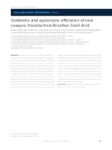Por favor, use este identificador para citar o enlazar este ítem:
http://www.alice.cnptia.embrapa.br/alice/handle/doc/1069698Registro completo de metadatos
| Campo DC | Valor | Lengua/Idioma |
|---|---|---|
| dc.contributor.author | MARINHO, R. de C. N. | pt_BR |
| dc.contributor.author | FERREIRA, L. de V. M. | pt_BR |
| dc.contributor.author | SILVA, A. F. da | pt_BR |
| dc.contributor.author | MARTINS, L. M. V. | pt_BR |
| dc.contributor.author | NÓBREGA, R. S. A. | pt_BR |
| dc.contributor.author | FERNANDES JUNIOR, P. I. | pt_BR |
| dc.date.accessioned | 2017-05-17T11:11:11Z | pt_BR |
| dc.date.available | 2017-05-17T11:11:11Z | pt_BR |
| dc.date.created | 2017-05-17 | pt_BR |
| dc.date.issued | 2017 | pt_BR |
| dc.identifier.citation | Bragantia, v. 76, n. p. 273-281, 2017. | pt_BR |
| dc.identifier.uri | http://www.alice.cnptia.embrapa.br/alice/handle/doc/1069698 | pt_BR |
| dc.description | Cowpea is a very important crop to Brazilian Semi-Arid mainly small family-based farmers. Rhizobia inoculation is a practice, easy to use, and cheap technology that increases cowpea productivity. The aim of this study was to evaluate the efficiency of two new rhizobia isolates in greenhouse and field as well as classify them taxonomically. To bacterial identification the 16S rRNA gene of ESA 17 and ESA 18 isolates were sequenced. The greenhouse test was conducted with pots containing 3 L of soil and the bacterial isolates evaluated were ESA 17, ESA 18,BR 3267 or BR 3262 strains. A field experiment was implemented on a Vertisol in Juazeiro, Bahia State, to evaluate the cowpea growth and productivity. In this experiment, the peat-based inoculants with ESA 17, ESA 18, BR 3267 or UFLA 3-84 were used in 2 cowpea cultivars. Both bacteria were identified as Bradyrhizobium, but related to different species. ESA 17 was related to B. japonicumand ESA 18 was closer to B. pachyrhizi. At greenhouse, both isolates increased cowpea nitrogen content in the shoots due to the presence of very efficient nodules. In the field, the isolate ESA 18 inoculated at BRS Pujante cultivar induced higher production than observed for the absolute control, and for BR 17 Gurguéia cultivar, he ESA 17 and BR 3267 stood out both by inducing high production and grain protein content. The results indicate that both isolates can be evaluated in network experiments aiming at official recommendation for new bacteria to cowpea inoculant in Brazil. | pt_BR |
| dc.language.iso | eng | eng |
| dc.rights | openAccess | eng |
| dc.subject | Caupi | pt_BR |
| dc.subject | Rizóbio | pt_BR |
| dc.subject | Fixação biológica de azoto | pt_BR |
| dc.subject | Seleção de estirpes | pt_BR |
| dc.subject | Vale do Rio São Francisco | pt_BR |
| dc.subject | Biological nitrogen fixation | pt_BR |
| dc.subject | Cowpea | pt_BR |
| dc.title | Symbiotic and agronomic efficiency of new cowpea rhizobia from Brazilian Semi-Arid. | pt_BR |
| dc.type | Artigo de periódico | pt_BR |
| dc.date.updated | 2018-01-18T11:11:11Z | pt_BR |
| dc.subject.thesagro | Feijão de corda | pt_BR |
| dc.subject.thesagro | Inoculante | pt_BR |
| dc.subject.thesagro | Biologia do Solo | pt_BR |
| dc.subject.thesagro | Rhizobium | pt_BR |
| dc.subject.nalthesaurus | Bradyrhizobium | pt_BR |
| riaa.ainfo.id | 1069698 | pt_BR |
| riaa.ainfo.lastupdate | 2018-01-18 -02:00:00 | pt_BR |
| dc.identifier.doi | 10.1590/1678-4499.003 | pt_BR |
| dc.contributor.institution | RITA DE CÁSSIA NUNES MARINHO, Universidade Federal do Piauí - Departamento de Fitotecnia - Bom Jesus, PI; LINNAJARA DE VASCONCELOS MARTINS FERREIRA, Instituto Federal do Pará - Campus Rural de Marabá - Marabá, PA; ALEKSANDRO FERREIRA DA SILVA, UFRPE; LINDETE MÍRIA VIEIRA MARTINS, Universidade do Estado da Bahia - Departamento de Tecnologia e Ciências Sociais - Juazeiro, BA; RAFAELA SIMÃO ABRAHÃO NÓBREGA, Universidade Federal do Recôncavo Baiano - Centro de Ciências Agrárias, Ambientais e Biológicas, Cruz das Almas, BA; PAULO IVAN FERNANDES JUNIOR, CPATSA. | pt_BR |
| Aparece en las colecciones: | Artigo em periódico indexado (CPATSA)  | |
Ficheros en este ítem:
| Fichero | Descripción | Tamaño | Formato | |
|---|---|---|---|---|
| PauloIvan2017.pdf | 608,17 kB | Adobe PDF |  Visualizar/Abrir |









